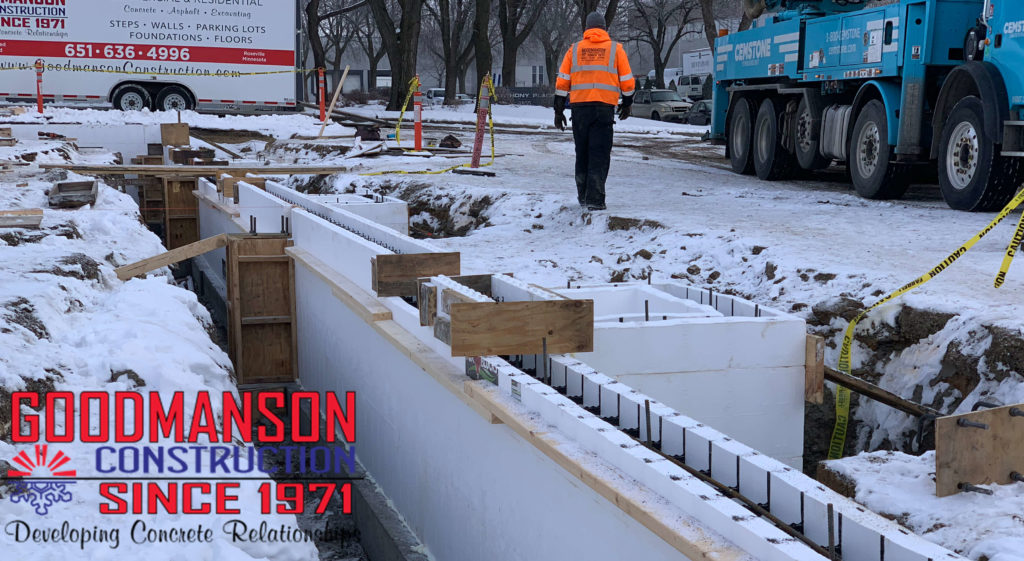Are Commercial and Industrial Foundations different than Residential Foundations?

Both Commercial and residential foundations do the same thing: they support the weight of whatever is built on top. The foundation secures the structure to the earth and provides a counter-force to the forces of gravity and wind acting upon the structure. Regardless of what you’re building, the foundation has to be sound or the building might just collapse.
Typically when you’re talking about residential foundations you’re talking about concrete block versus poured concrete. But we want to get into something a little different and a bit more specified today.
It’s not necessarily that the same topics in residential foundations don’t come up when you’re talking about commercial and industrial applications. They certainly can. But we talk about commercial and industrial foundations a little bit differently and use some different terminology. And that could use a little explanation.

Commercial Building Foundations: T-Shaped, Slab on Grade and Drilled Pier.
Building a commercial concrete foundation, or any foundation for that matter, you have to take into account things like the condition and composition of the soil, the height of the building and the climate of the area.
Most of the time, when Goodmanson Construction gets called to do a foundation, the engineer has already worked out what kind of foundation is needed for a particular project. We might make a recommendation or two, but the job of deciding the foundation is best left to the engineers and architects to work out.
For example, for a poured concrete project involving some kind of basement, we may recommend using Insulated Concrete Forms.
Insulated Concrete Form Foundation
Insulated Concrete Forms are what we use (along with polystyrene insulation) that have really revolutionized our process in terms of how we are able to give customers greater value on their foundation project. Insulated Concrete Forms aren’t so much a foundation design as a particular type of poured concrete wall.
Instead of being poured into standard molds for the foundation walls, ICF foundations are poured into what look like styrofoam lego blocks. This styrofoam like material acts as insulation to the concrete, giving it a greater R value (resistance value) to the cold.
There are a lot of advantages to doing ICF foundations especially in Minnesota, but we will save that for another blog on its own. Let’s get to talking about particular kinds of foundation design that we’ve worked on!
T-Shaped Foundation
This type of foundation design is the most commonly used when dealing with tall buildings and areas where it is likely to freeze.
Frozen ground will exert extreme pressure on the foundation. The T-shaped foundation is designed so that it can resist damage from the pressure.
With footing design foundations, footings are installed beneath each column of the building just below the frost line. Pilasters will stretch to the bottom of each column. One continuous wall beam or wall will connect all the pilasters.
Concrete is then poured between the beams to fill in the space. The T-shape of the foundation provides not only protection from frost, but great stability for the building.
Slab On Grade Foundation
A Slab on Grade Foundation is probably the easiest concept to grasp: you make a mold on the ground, then you pour the concrete into the mold. Most of the time it’s directly onto the ground.
You’d see this a lot in warmer climates where the ground does not freeze, but a slab foundation can be adapted to serve our purposes in the frozen northlands.
Somewhat counterintuitively, Slab on Grade is a popular choice in Minnesota because of the soil type.
Minnesota soil is mostly expansive clay soil, and slab on grade is perfect for that kind of soil. Minnesota also has frost cycles, so Goodmanson Construction has to (in many cases) install a variant of the slab on grade called a frost protected shallow foundation.

Drilled Pier Foundation
A drilled pier is a deep foundation solution. It is also referred to as a drilled shaft, caisson, bored pile, or cast-in-drilled-hole pile.
To make a drilled pier foundation the first thing you need to do is drill a hole. Through specialized drilling equipment, we put a cylindrical shaft deep into the ground and then fill the shaft with concrete.
A drilled pier can range in diameter from 24” up to 120” and can be installed in depths ranging up to 300 feet or more.
Drilled Pier Foundations are popular in industrial applications in Minnesota for a few different factors:
- A weak or unstable upper soil layer.
- Presence of horizontal forces against the foundation.
- Presence of expansive soils. (like clay!)
- Presence of uplifting forces in the soil. (like frost heaving)
- Serious soil erosion.
We’ve had a lot of experience working on industrial projects, pipeline projects and tank projects that have required drilled pier foundations. For industrial applications like this, drilled pier foundations could give you the best bang for your buck!

Choosing the right Foundation is key for the success of a commercial or industrial project, and choosing the right contractor for building that foundation is equally as important.
While we can’t tell you what foundation is going to be best for your building (you’re going to want to talk to an engineer or an architect about that one) we can tell you that getting the right contractor to pour the foundation is critical for the project’s success.
You want a contractor that has a team with both the technology and the technical expertise to meet the design standards your building needs. You also need someone who understands the different complicating factors to foundations in Minnesota.
It matters who is pouring the concrete. If you’re an engineer, management company or a general contractor and this is a job you can’t afford to get wrong, there’s only one thing you should be doing: calling Goodmanson Construction.
Our estimators are ready to evaluate your project, no matter the application. Submit an estimate request today!

